Ambassador post originally published on Medium by Dotan Horovits
This is a summary of the CNCF’s KubeCon+CloudNativeCon NA 2024 recap live stream event hosted on November 19th.
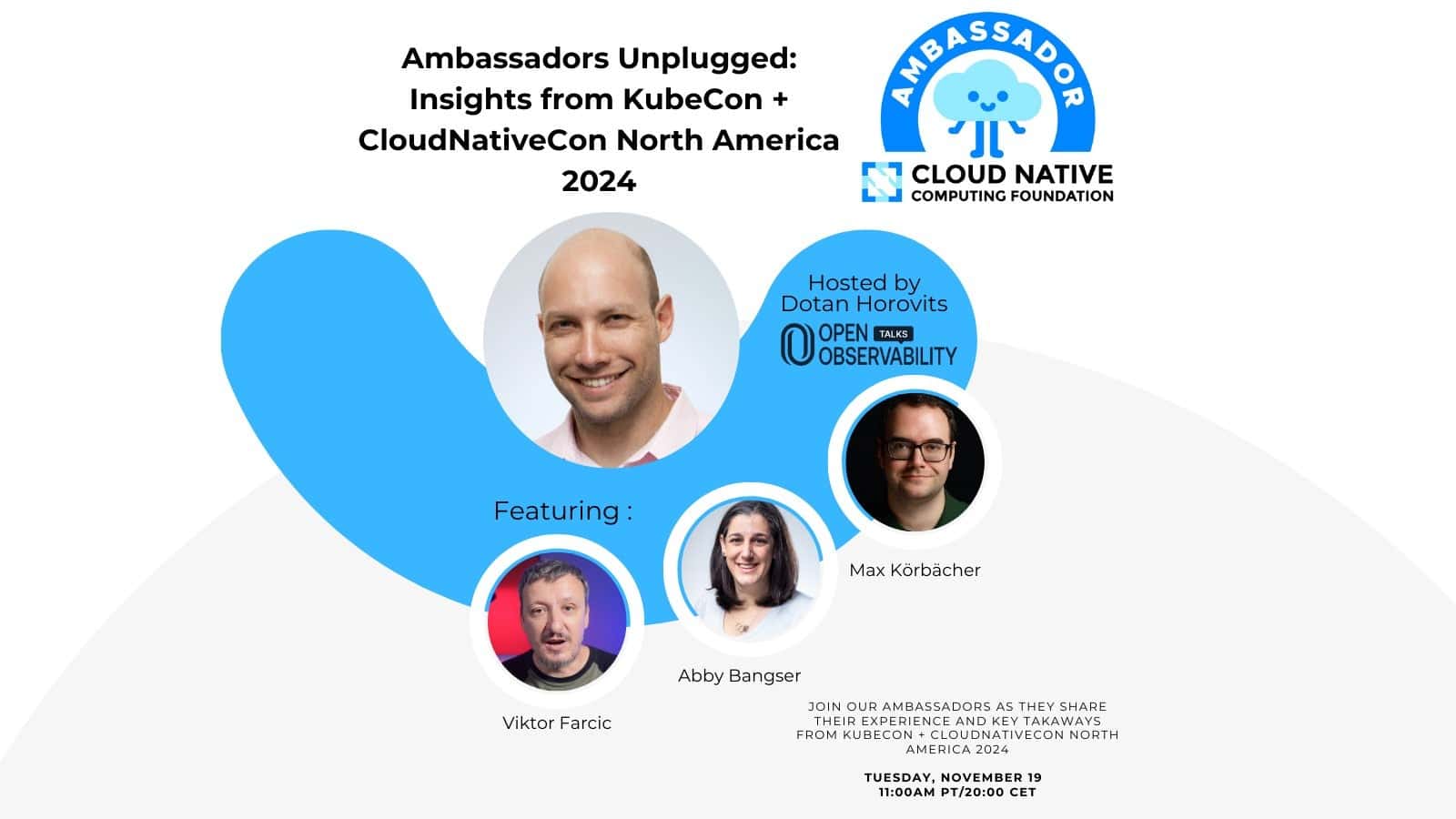
Want to catch up on KubeCon’s highlights and takeaways? Take it from the experts who know the cloud-native space inside out — the CNCF Ambassadors!
I’d like to thank the Cloud Native Computing Foundation (CNCF), the organization behind KubeCon, for inviting me to host its official KubeCon+CloudNativeCon North America 2024 recap session. The CNCF hosts Kubernetes, Argo, Backstage, OpenTelemetry and over 200 other cloud-native projects we know and love. You can find the full recording of the session on the KubeCon + CloudNativeCon Salt Lake City 2024 playlist on the CNCF’s official YouTube channel.
In this recap session I sat down with fellow CNCF Ambassadors and cloud-native experts Viktor Farcic and Max Körbächer to unpack the major project announcements and key themes from Salt Lake City: the standout talks, co-located events, and those memorable hallway conversations.
In this post, I’ll share a recap of that highlight-packed hour-long discussion. Let’s go!
Expert panel: Viktor Farcic and Max Körbächer
Viktor Farcic is a lead rapscallion at Upbound and a published author. He is a host of the YouTube channel DevOps Toolkit and a co-host of DevOps Paradox. Or as he presented himself: “the Crossplane guy”.
Max Körbächer is Co-Founder at Liquid Reply. He is Co-Chair of the CNCF Environmental Sustainability Technical Advisory Group and served 3 years at the Kubernetes release team. He runs the Munich Kubernetes Meetup as well as the Munich and Ukraine Kubernetes Community Days.
The state of KubeCon and the Cloud Native ecosystem
What an amazing KubeCon we had at Salt Lake City! It was the largest KubeCon in North America after the Covid pandemic, hosting over 9,000 attendees.
It was also amazing to see the hands raised when Chris Aniszczyk, the CTO of the CNCF, asked at the opening keynote who’s a first-timer, and half of the crowd raised their hands. Chris confirmed we have about 50% new folks. Stay tuned for the CNCF’s transparency report, as we always publish after these events.

This year’s KubeCon was also an opportunity to celebrate a decade to Kubernetes, the project that started the CNCF and the cloud-native ecosystem. It’s astonishing to see how it has grown: at the time of this KubeCon we have 208 projects under the CNCF, run by 255k contributors from across 193 countries. The CNCF landscape is getting crowded (so much so, that I started guiding people on how to navigate the CNCF landscape :-))
Let’s look at some KubeCon news and highlights from these projects.
Flatcar joins the CNCF: a cloud-native Linux OS
A new joiner to the CNCF is Flatcar. It’s actually the first time the CNCF has adopted an operating system distribution. As Chris Aniszczyk rightly put it: “A secure community-owned cloud native operating system was one of the missing layers of the CNCF technology stack”.
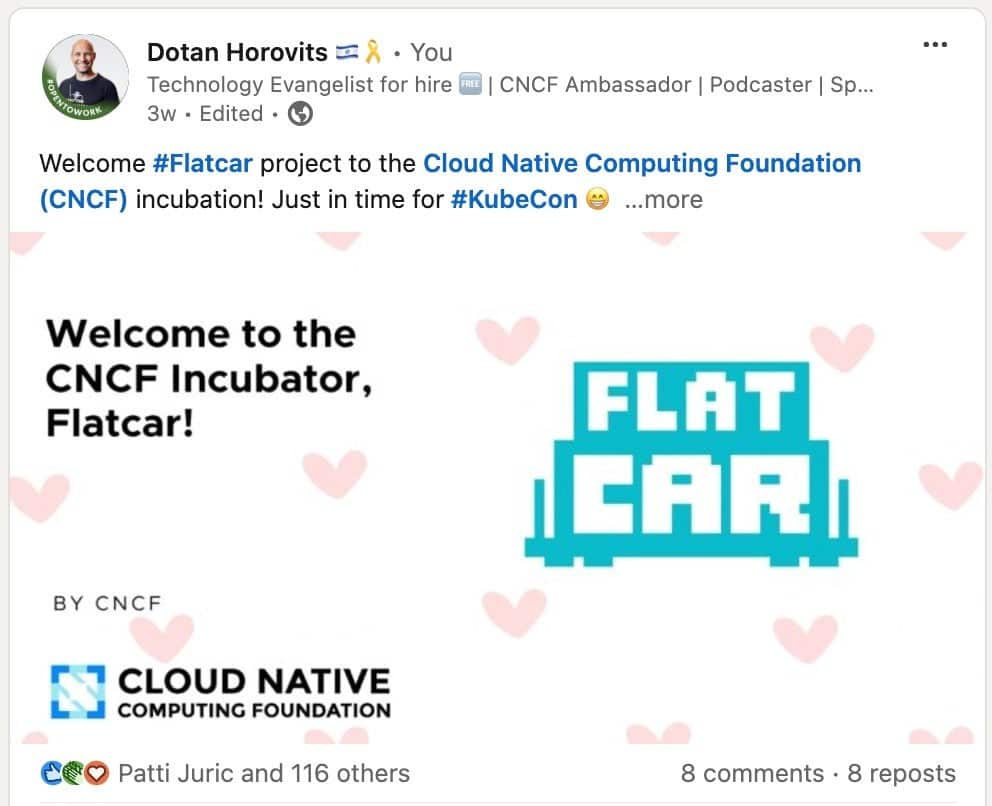
Flatcar provides a lightweight Linux OS, derived from CoreOS, that is specifically tailored for hosting container workloads. Max says it has always been handing around, who’s going to take care of the project. He points out its value for platform engineers who look for the recommended golden image for their organization.
Viktor noted that while an important addition, it’s a low-level component to which end-users don’t get exposed and don’t really care, especially if running on managed Kubernetes like EKS and GKE.
A big kudos to the Kinvolk team that originally developed it, and to Microsoft for evolving it these past years since the acquisition and now contributing it to the CNCF Sandbox. For more details, check out the announcement.
wasmCloud matures into incubation: WebAssembly at the CNCF
Alongside new projects joining the CNCF Sandbox, we see projects maturing from Sandbox to Incubation, one of which wasmCloud, the popular WebAssembly platfrom.

I’ve noted in the past that WebAssembly is the next frontier in cloud-native evolution, and wasmCloud is a cornerstone of this movement within the CNCF stack. The project has over a 100 regular contributors representing 73 unique companies.
wasmCloud is deployed by major organizations such as Adobe, Orange, MachineMetrics, TM Forum member CSPs, and Akamai Technologies. It’s interesting to see the wide variety of use cases for wasmCloud out there, from industrial IoT and automotive to digital services and banking. Max notes in particular the talk by Siemens at wasmCon co-located event, in which their shared their use case for embedded development.
Viktor thinks that WASM isn’t here to replace containers, but rather provides its value alongside containers, with use cases such as edge computing. Max notes that if you run WASM in Kubernetes, it can practically leverage all the ecosystem of Kubernetes. For more on the wasmCloud maturation, check out the announcement blog.
Dapr and cert-manager reach CNCF graduation
The highest maturity level in the CNCF is Graduation. This KubeCon we saw two important projects reaching graduation: Dapr and cert-manager.
Dapr, the Distributed Application Runtime project, has today 3,700 individual contributors from more than 400 organizations, which is a good testament to the project’s maturity and sustainability. It is used by tens of thousands of organizations, including Grafana Labs, FICO, HDFC Bank, SharperImage.com and ZEISS.
There was a big graduation party with Dapr folks at Sale Lake City to celebrate this occasion. Congrats to Microsoft Azure team who founded it and are lead maintainers, to Diagrid who also leads it and all other maintainers and everyone involved. See the announcement post.
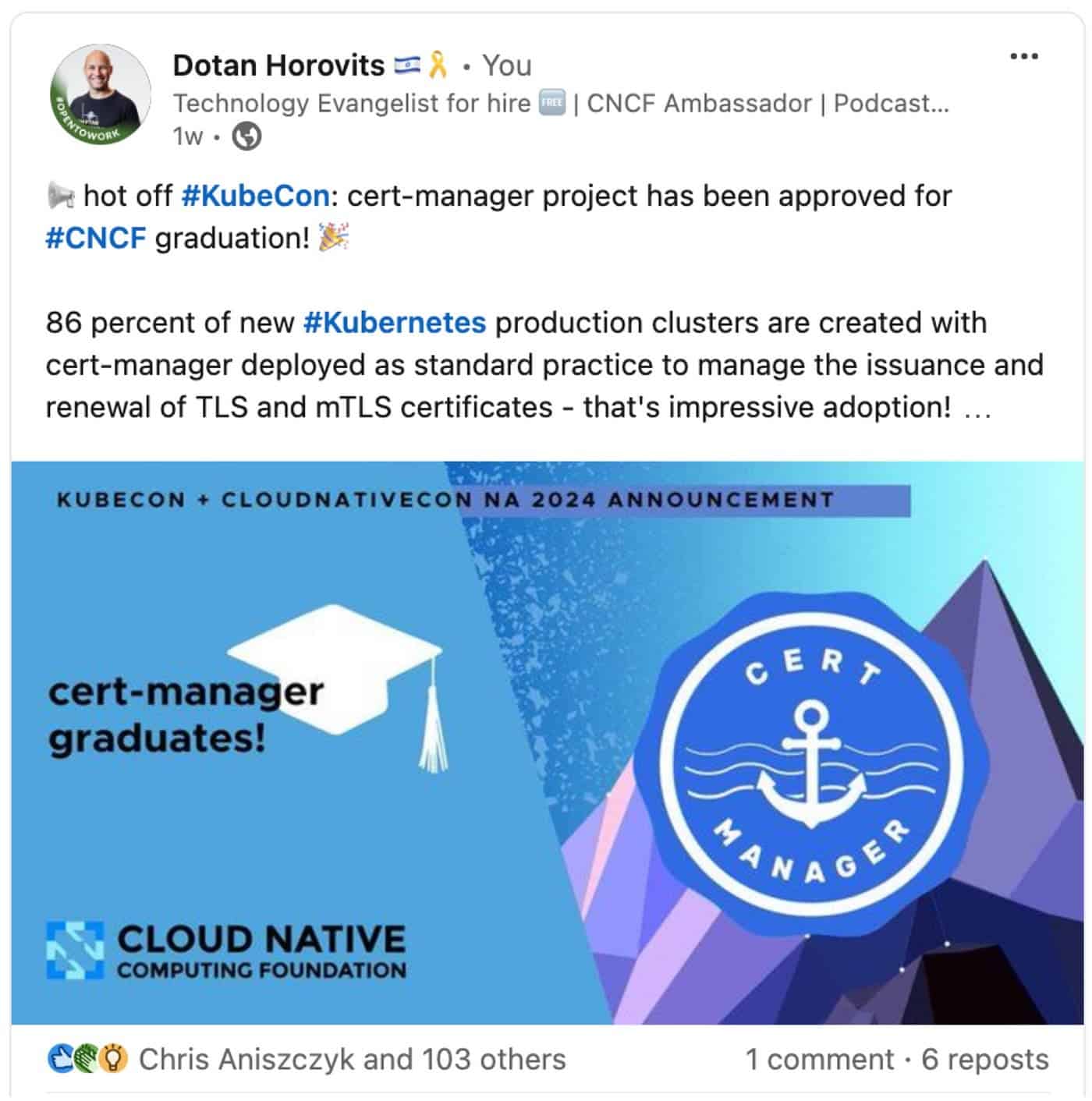
Another critical component in our Kubernetes stack reaching graduation is cert-manager project. It is no wonder this project is graduated, as it’s pretty much the de-facto standard for issuance and renewal of TLS and mTLS certificates these days, and we tend to take it for granted. In fact, 86 percent of new production clusters are created with cert-manager deployed as standard practice!
As we looked back at the times, a decade ago, when we could spend half a day setting certificates or failing clusters due to expired certificates, Viktor Max and I agreed it’s a bliss to have it baked in. See the announcement post.

Jaeger and Prometheues play nicely with OpenTelemetry
The biggest news on the observability front were the major releases of two graduated projects: Jaeger v2 and Prometheus v3. Interestingly, a clear silver lining goes through both these releases, and that’s OpenTelemetry.
Jaeger has been rearchitected to take advantage of the OpenTelemetry Collector framework, while Prometheus aims at becoming the de-facto backend for OpenTelemetry metrics. It’s wonderful to see the collaboration across these CNCF projects, driving for unified observability
On the OpenTelemetry side, we’ve shared during KubeCon the great work of the CI/CD Observability Special Interest Group (OTel CI/CD), which
For more information see the CNCF blog.
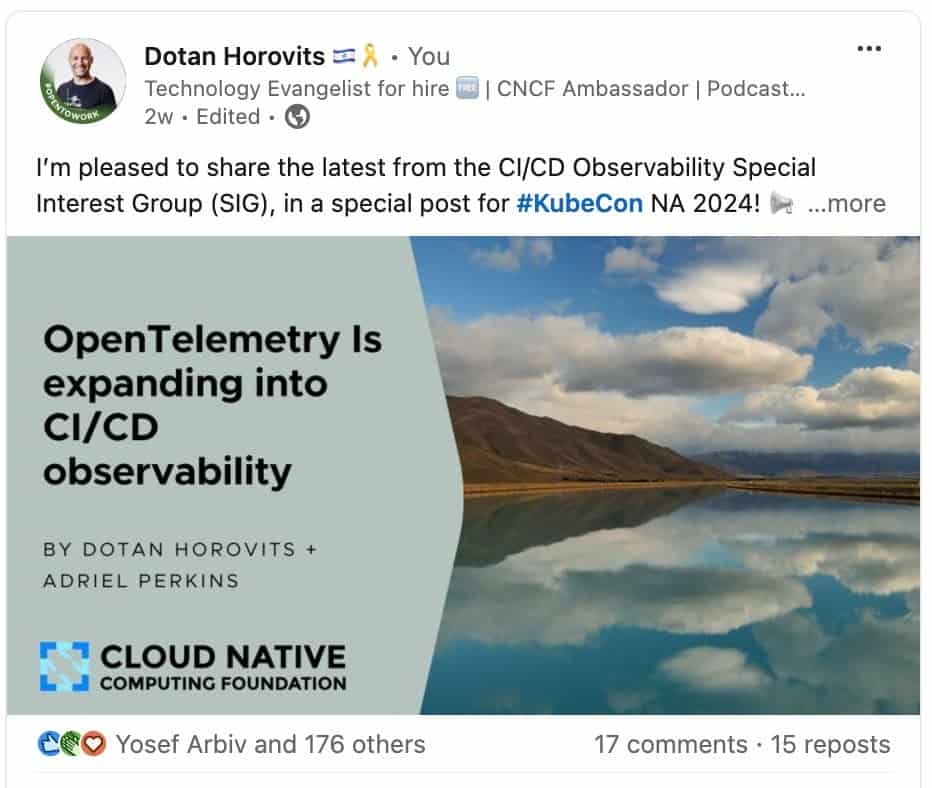
In addition, OpenMetrics has been archived and merged into Prometheus, and is now embarking on OpenMetrics 2.0. A new working group has been founded under Prometheus, and its first focus will be requirements gathering and scoping of the 2.0. This is your opportunity to influence. You can read more in this post.
Cloud Native reference architectures shared by CNCF end users
Alongside new projects, at the CNCF we look at how to help users design and architect their systems for the various use cases based on the cloud-native stack. The End User TAB (technical advisory board) is a forum to collect valuable end-user feedback and learnings.
Under the TAB, the Reference Architecture working group was formed to collect references and provide practical guidance and examples for building cloud native applications, and has launched its first Reference Architectures — Scaling through Platform Engineering at Allianz Direct and Scaling Adobe’s Service Delivery Foundation with a Cell-based Architecture.
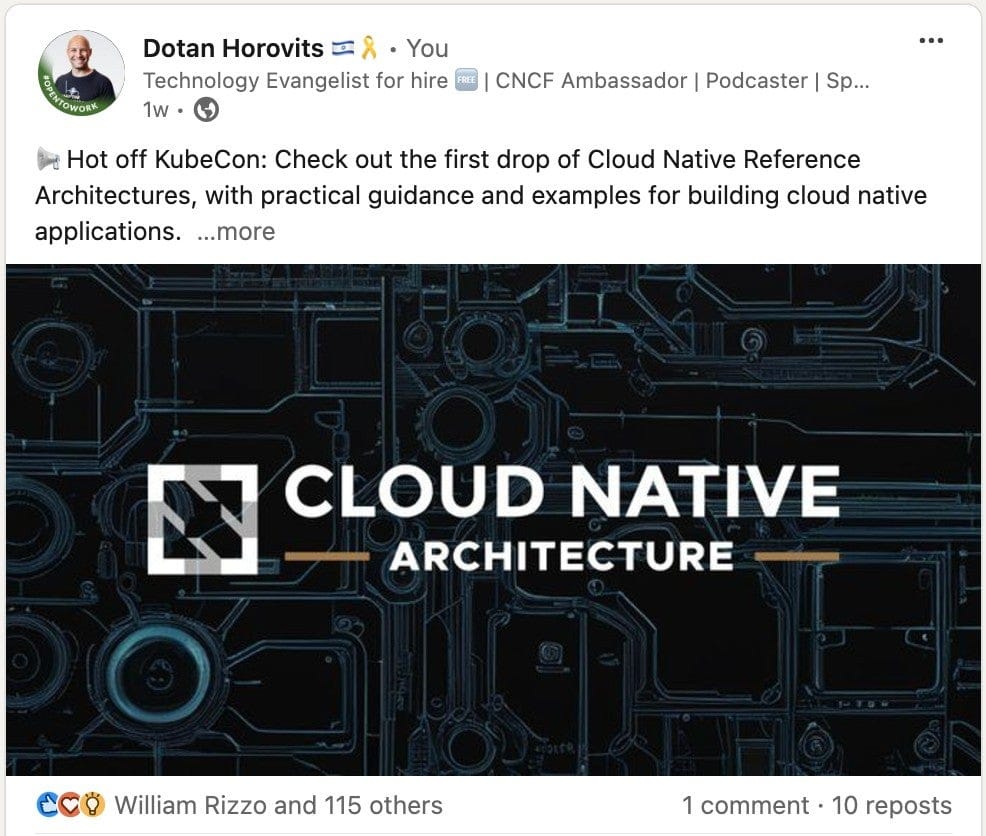
As a former systems architect, these real-life architecture patterns have often been a topic of my discussions at KubeCon and other community gatherings. I’m excited at this new initiative, as it facilitates this sort of discussion and enables the community to share design blueprints from large-scale production deployments in an organized fashion.
We now have a new dedicated CNCF sub-domain for that: architecture.cncf.io. Bookmark it, as I expect to see more reference architectures added there over time. In fact, you can also submit your own reference architecture in that page, to share it with the world.
That’s not all
What? no AI? don’t worry. On our hour-long fireside chat we covered artificial intelligence and machine learning, which have been a major theme this KubeCon, as well as platform engineering, environmental sustainability initiatives and many more topics.
Check out the full episode on YouTube or on OpenObservbability Talks on all major podcast apps.